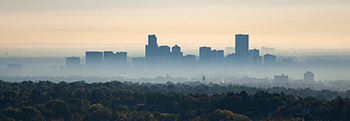2014 News & Events
Air Quality Research along Colorado's Front Range
15 July 2014
modified from the story by CIRES Communications

Every summer along Colorado's Front Range, ozone pollution periodically spikes to unhealthy levels, despite federal and state efforts to control the lung-damaging chemical. Cars are running cleaner, and power plants are emitting fewer pollutants, but ozone still regularly soars above health-based limits.
This July and August, nearly 200 scientists from several national and regional agencies will focus sophisticated instruments on the Front Range atmosphere, seeking to better understand the sources of emissions and the chemistry that contribute to regional air quality challenges. Ultimately, the goal is to share discoveries with decision makers seeking to clear the air.
When ozone levels spike, Environmental Protection Agency (EPA) experts recommend that people, especially those in sensitive groups – children, the elderly, and anyone with pre-existing respiratory conditions – limit time outdoors. Seven years ago, Colorado's Front Range fell out of compliance with federal regulations designed to protect people's health.
The NSF sponsored Front Range Air Pollution and Photochemistry Experiment (FRAPPÉ) through the National Center for Atmospheric Research (NCAR) and the NASA sponsored Deriving Information on Surface conditions from Column and Vertically Resolved Observations Relevant to Air Quality (DISCOVER-AQ) mission take place in Summer 2014. Three aircraft, including the NASA P-3 and King Air and the NSF / NCAR C-130, will make detailed atmospheric measurements, supported by other instruments on the ground. NOAA and CIRES scientists are contributing primarily with ground-, tower-, vehicle-, and balloon-based instruments: